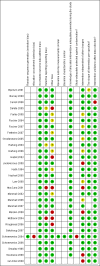Pharmaceutical policies: effects of restrictions on reimbursement
- PMID: 20687098
- PMCID: PMC6791298
- DOI: 10.1002/14651858.CD008654
Pharmaceutical policies: effects of restrictions on reimbursement
Abstract
Background: Public policy makers and benefit plan managers need to restrain rising pharmaceutical drug costs while preserving access and optimizing health benefits.
Objectives: To determine the effects of a pharmaceutical policy restricting the reimbursement of selected medications on drug use, health care utilization, health outcomes and costs (expenditures).
Search strategy: We searched the 14 major bibliographic databases and websites (to January 2009).
Selection criteria: Included were studies of pharmaceutical policies that restrict coverage and reimbursement of selected drugs or drug classes, often using additional patient specific information related to health status or need. We included randomised controlled trials, non-randomised controlled trials, interrupted time series (ITS) analyses, repeated measures studies and controlled before-after studies set in large care systems or jurisdictions.
Data collection and analysis: Two authors independently extracted data and assessed study limitations. Quantitative re-analysis of time series data was undertaken for studies with sufficient data.
Main results: We included 29 ITS analyses (12 were controlled) investigating policies targeting 11 drug classes for restriction. Participants were most often senior citizens or low income adult populations, or both, in publically subsidized or administered pharmaceutical benefit plans. Impact of policies varied by drug class and whether restrictions were implemented or relaxed. When policies targeted gastric-acid suppressant and non-steroidal anti-inflammatory drug classes, decreased drug use and substantial savings on drugs occurred immediately and for up to two years afterwards, with no increase in the use of other health services (6 studies). Targeting second generation antipsychotic drugs increased treatment discontinuity and the use of other health services without reducing overall drug expenditures (2 studies). Relaxing restrictions for reimbursement of antihypertensives and statins increased appropriate use and decreased overall drug expenditures. Two studies which measured health outcomes directly were inconclusive.
Authors' conclusions: Implementing restrictions to coverage and reimbursement of selected medications can decrease third-party drug spending without increasing the use of other health services (6 studies). Relaxing reimbursement rules for drugs used for secondary prevention can also remove barriers to access. Policy design, however, needs to be based on research quantifying the harm and benefit profiles of target and alternative drugs to avoid unwanted health system and health effects. Health impact evaluation should be conducted where drugs are not interchangeable. Impacts on health equity, relating to the fair and just distribution of health benefits in society (sustainable access to publically financed drug benefits for seniors and low income populations, for example), also require explicit measurement.
Conflict of interest statement
PF, CR, PF. None known. MM is employed by the Ministry of Health Services of British Columbia in the position of Co‐Director of Research and Evidence Development in Pharmaceutical Services Division, which uses PA policies as part of a suite of policies for managing the cost‐effectiveness of its drug benefits program, PharmaCare. CG has previously been under contract to the Pharmaceutical Services Division of the Ministry of Health Services of British Columbia to produce reviews of evidence. MA is employed by Statens legemiddelverk of the Norwegian Medicines Agency which ensures cost‐efficient, effective and well‐documented use of medicines in Norway.
Figures
Comment in
-
Pharmaceutical policies: effects of restrictions on reimbursement.Obstet Gynecol. 2011 Jan;117(1):172-173. doi: 10.1097/AOG.0b013e31820452f1. Obstet Gynecol. 2011. PMID: 21173660 No abstract available.
References
References to studies included in this review
-
- Bjerrum L, Larsen J, Kragstrup J. Guidelines accompanied by changes in reimbursement rules: effects on lipid‐lowering drug prescribing. Scandinavian Journal of Primary Health Care 2001;19:158‐62. - PubMed
-
- Carroll NV, Smith JC, Berringer RA, Oestreich GL. Evaluation of an automated system for prior authorization: a COX‐2 inhibitor example. American Journal of Managed Care 2006;12:501‐8. - PubMed
-
- Delate T, Mager DE, Sheth J, Motheral BR. Clinical and financial outcomes associated with a proton pump inhibitor prior‐authorization program in a Medicaid population. American Journal of Managed Care 2005;11:29‐36. - PubMed
-
- Farley JF, Cline RR, Schommer JC, et al. Retrospective assessment of Medicaid Step‐Therapy Prior Authorization Policy for atypical antipsychotic medications. Clinical Therapeutics 2008;30(8):1524‐39. - PubMed
References to studies excluded from this review
-
- Bloom BS, Jacobs J. Cost effects of restricting cost‐effective therapy. Medical Care 1985;23:872‐80. - PubMed
-
- Gleason PP, Williams C, Hrdy S, Hartwig SC, Lassen D. Medical and Pharmacy ExpendituresAfter Implementation of a Cyclooxygenase‐2 Inhibitor Prior Authorization Program. Pharmacotherapy 2005 Jul;25(7):924‐34. - PubMed
-
- Kotzan JA, McMillan JA, Jankel CA, et al. Initial impact of a Medicaid prior authorization program for NSAID prescriptions. Journal of Research in Pharmaceutical Economics 1993;5:25‐41.
Additional references
-
- Aaserud M, Dahlgren AT, Sturm H, Kösters JP, Hill S, Furberg CD, et al. Policies: effects on rational drug use, an overview of 13 reviews.. Cochrane Database of Systematic Reviews 2003, Issue 2. [DOI: DOI:10.1002/14651858.CD004397.pub2.]
-
- Aaserud M, Dahlgren AT, Kösters JP, Oxman AD, Ramsay C, Sturm H. Pharmaceutical policies: effects of reference pricing,other pricing, and purchasing policies.. Cochrane Database of Systematic Reviews 2006, Issue 2. [DOI: DOI:10.1002/14651858] - PubMed
-
- Bosch X, Loma‐Osorio P, Marrugat J. Platelet glycoprotein IIb/IIIa blockers for percutaneous coronary intervention and the initial treatment of non‐ST segment elevation acute coronary syndromes. Cochrane Database of Systematic Reviews 2001, Issue 4. [DOI: 10.1002/14651858] - DOI
-
- Carlson AM, Williams SE, Wagner S. Prior authorization of pharmaceuticals: health policy in search of evaluation. Research in Healthcare Financial Management 2003;8(1):1‐6.
Publication types
MeSH terms
Substances
Grants and funding
LinkOut - more resources
Full Text Sources



